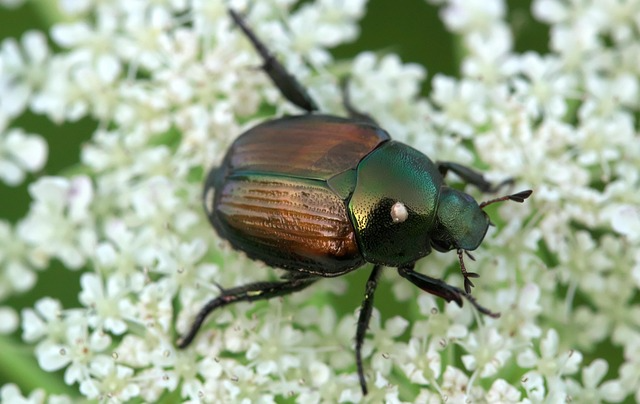Table of Contents
Scientific Classification
| Category | Classification |
|---|---|
| Kingdom | Animalia |
| Phylum | Arthropoda |
| Class | Insecta |
| Order | Coleoptera |
| Family | Scarabaeidae |
| Genus | Popillia |
| Species | Popillia japonica |
| Common Name | Japanese Beetle |
Introduction
The Japanese beetle (Popillia japonica) is hard to miss with its shiny green body and copper wings, but don’t let its looks fool you. This little critter is one of North America’s most notorious invasive pests. It hitchhiked its way from Japan over a century ago and has since wreaked havoc on gardens, farms, and landscapes across the U.S. and Canada.
Though it’s small, the Japanese beetle certainly makes its presence known. It’s a voracious eater, munching on more than 300 different plant species. It skeletonizes leaves and damages fruits, flowers, and turfgrass. Ironically, despite the destruction it causes, many are drawn to its striking appearance.
In this article, we’ll dive into everything you need to know about the Japanese beetle. We’ll explore its biology, behavior, the extent of its damage, and effective ways to manage it. Whether you’re a gardener, a farmer, or just someone who loves nature, understanding this insect will help you either coexist with it or combat its effects more effectively.
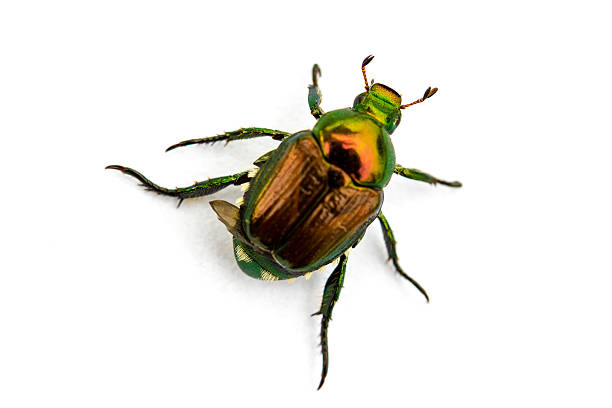
Description
The Japanese beetle is a small but striking insect, measuring around ½ inch (13 mm) long. While it may be petite, it certainly makes a big impression with its looks and the trouble it can cause.
Color: One of its most eye-catching features is its shiny metallic green thorax and head, complemented by gleaming bronze-copper elytra, which are the protective wing covers.
Shape: Its body is oval and domed, a common shape among scarab beetles.
Legs: This little critter has six legs equipped with tiny claws that help it cling to leaves and flowers.
White tufts: On each side of its abdomen, you’ll find five white tufts of hair, plus two more at the back. These distinctive tufts are a handy way to differentiate it from other similar beetles.
Adult Japanese beetles are not just pretty; they’re also quite the munchers. They feast on a variety of plants and often gather in groups, which can lead to even more significant damage.
Distribution
The Japanese beetle hails from Japan, where it doesn’t cause much trouble. That’s mainly because its population is kept in check by natural predators and environmental factors.
Invasion of North America
This pesky beetle made its debut in the U.S. back in 1916, when it was spotted in a nursery in Riverton, New Jersey. It probably hitched a ride here accidentally, tucked away in a shipment of iris bulbs.
Since then, it has spread rapidly across many areas in the eastern and central U.S., and it has even made its way into parts of Canada, particularly Ontario and Quebec.
Current Range in the U.S.
Today, Japanese beetles can be found in over 30 states, stretching from Maine all the way down to Georgia and as far west as Colorado. Some western states, like California, Oregon, and Washington, have implemented strict quarantines to help prevent the spread of diseases.
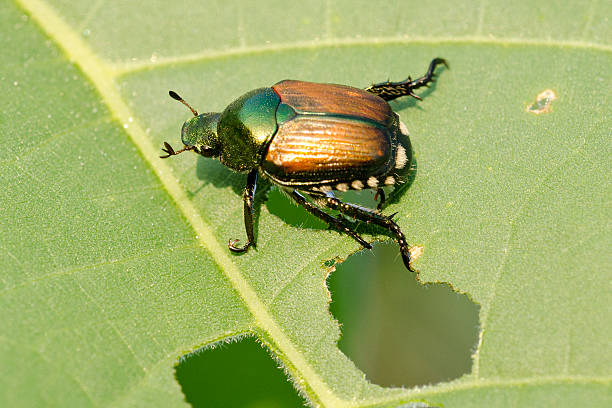
Habitat
Japanese beetles are incredibly versatile and can flourish in a variety of settings.
Preferred Habitats
– Urban gardens and lawns
– Orchards and vineyards
– Parks and golf courses
– Farmlands and pastures
These beetles thrive in warm, moist soil, which is ideal for laying eggs and nurturing their larvae. Well-kept lawns are especially at risk since they offer perfect spots for both feeding and breeding.
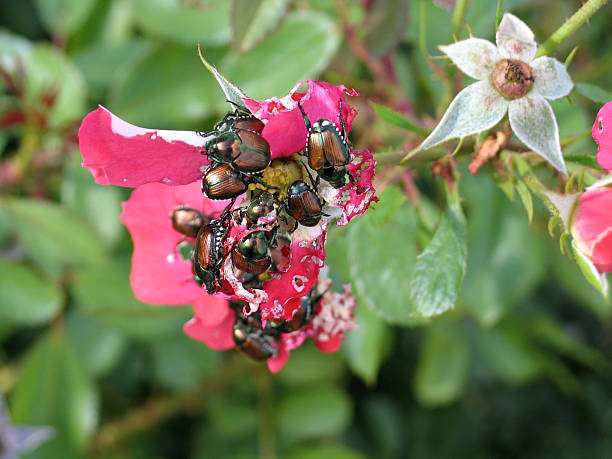
Diet
The Japanese beetle has a big problem: it eats a wide variety of plants.
Adult Beetles
Adult beetles eat the leaves, flowers, and fruits of more than 300 plant types, such as:
- Roses
- Grapes
- Apples
- Peaches
- Soybeans
- Corn
- Linden trees
- Birches
- Elms
They skeletonize leaves. This means they eat the tissue between the veins, which leaves a lacy look.
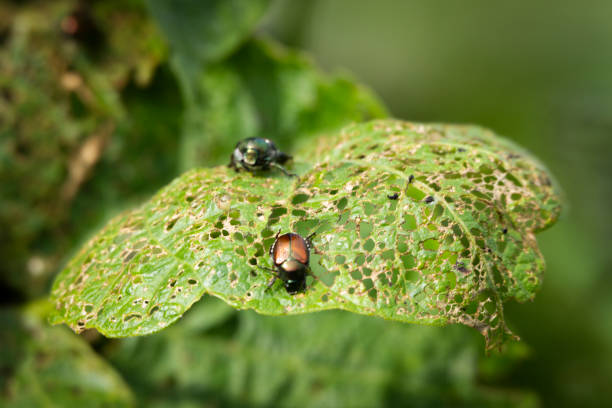
Larvae (Grubs)
Grubs live underground and feed primarily on grass roots, which can lead to:
- Turf damage
- Brown patches in lawns
- Increased vulnerability to drought
- Secondary damage by skunks and birds digging for grubs
Behavior
Japanese beetles are social creatures that love to feed and mate in groups. This behavior plays a big role in their ecological dominance in areas where they invade.
Daily Routine
Morning: They start their day munching on low-growing plants like roses.
Afternoon: They then move up to higher foliage.
Evening: This is when they mate and lay their eggs.
Night: As night falls, adults often retreat back to the soil or the base of plants.
Swarming and Aggregation
Japanese beetles emit pheromones that draw in more beetles to the same plant, leading to increased damage. Their vibrant colors and tendency to gather in groups make infestations quite noticeable and often concerning.
Lifecycle and Reproduction
The lifecycle of the Japanese beetle consists of four distinct stages: egg, larva (or grub), pupa, and adult. Typically, this entire process takes about a year to complete in most climates.
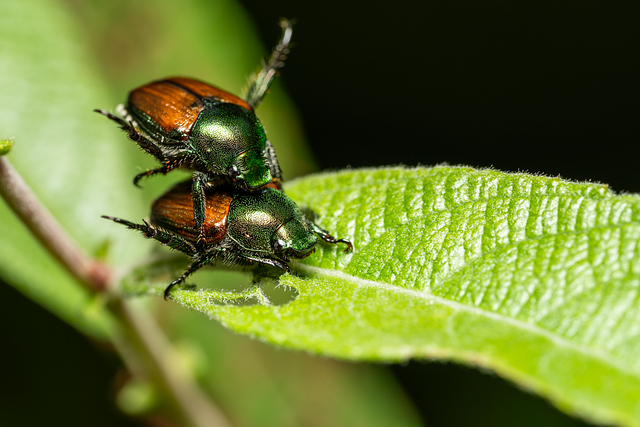
1. Egg Stage
- Laid in moist soil during summer (usually July–August)
- Females lay 40–60 eggs over several weeks
- Eggs hatch within two weeks
2. Larval Stage (Grub)
- White, C-shaped grubs live underground
- Feed on grass and crop roots
- Go through three instar stages (molting stages)
- Overwinter by burrowing deeper into soil
- Resurface in spring to feed briefly before pupating
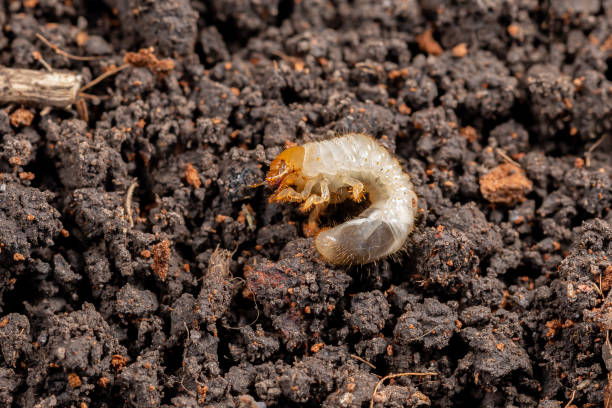
3. Pupal Stage
- Occurs in late spring
- Grubs create earthen cells and transform into adults
- Pupal stage lasts 10–14 days
4. Adult Stage
- Emerge in early to mid-summer
- Live 30–45 days
- Feed, mate, and begin the cycle anew
Predators and Natural Enemies
In their native range, Japanese beetles are controlled by natural predators. However, in North America, biological resistance is low, though some control methods exist.
Natural Predators
- Birds: starlings, robins, crows, and grackles
- Mammals: skunks, raccoons, moles (mostly target grubs)
- Insects: ants and ground beetles
- Parasites: tachinid flies and tiphiid wasps
Adaptations
The Japanese beetle is a successful invader due to its special biology and behavior:
- Broad diet: Ability to feed on 300+ plant species
- Hard elytra: Protects soft wings and body
- Pheromones: Aid in group aggregation and mating
- Efficient reproduction: High egg output in suitable soil
- Overwintering strategy: Burrow deep to survive cold seasons
These adaptations help them thrive in different climates and resist light environmental stress.
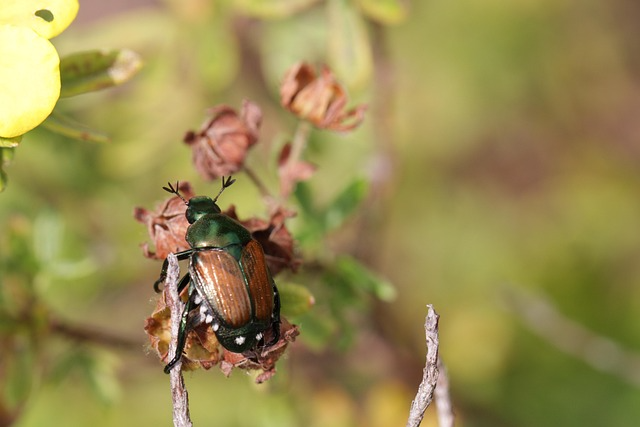
Invasive Impact and Agricultural Damage
The Japanese beetle is one of the most destructive plant pests in the United States.
Agricultural Impact
- Corn and soybean fields suffer yield losses from defoliation
- Orchards experience damaged fruit and reduced crop value
- Vineyards face contamination and appearance issues
Turf and Landscaping Damage
- Grub infestations in lawns cause costly damage
- Landscapers and golf courses spend millions on control each year
- Damaged turf can invite secondary predators like birds and skunks
Japanese Beetle Control and Management
Controlling Japanese beetles isn’t easy. However, integrated pest management (IPM) is the best method.
Cultural Controls
- Remove infested plants
- Rotate crops and use resistant varieties
- Water lawns deeply but infrequently to disrupt egg laying
Mechanical Methods
- Handpicking beetles in early morning
- Using traps is effective, but placement is key. If placed wrong, traps may attract more than they catch.
Biological Controls
- Milky spore disease (Paenibacillus popilliae): targets grubs
- Beneficial nematodes: microscopic worms that parasitize grubs
- Parasitic wasps and flies: lay eggs inside beetles
Chemical Controls
- Insecticidal sprays: Sevin, neem oil, or pyrethrins
- Systemic insecticides: Can be used in severe cases, though they carry environmental risks
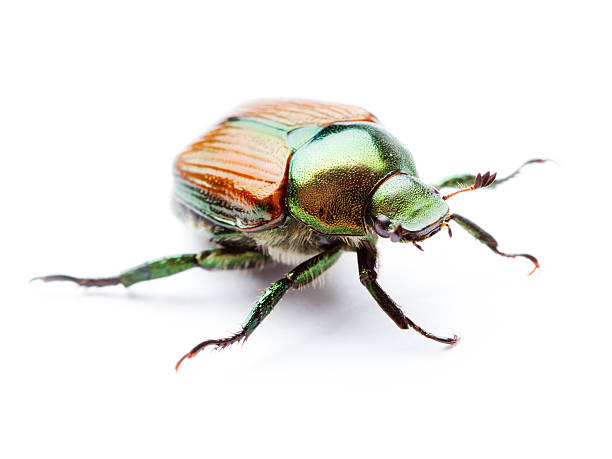
Conservation and Legal Status
The Japanese beetle isn’t considered endangered. In fact, it’s often viewed as a significant invasive pest in various regions.
Quarantine Programs
Certain states enforce strict quarantine measures. This is crucial for managing the spread of these beetles, particularly in the Pacific Northwest.
Environmental Considerations
While controlling the beetle population is essential, we also need to safeguard beneficial insects, such as pollinators. That’s why many states are advocating for eco-friendly pest control methods.
Interesting Facts
- Beauty and the Beast: Did you know that the vibrant colors of beetles come from special light-reflecting structures instead of pigments.
- Lacy Leaves: The term “skeletonizing” refers to how these little critters munch on leaf material, leaving just the veins behind.
- Pheromone Overload: Commercial traps utilize pheromones, which can lure in more beetles than they actually manage to catch.
- Grub Love: In the U.S., the larvae of Japanese beetles are the most common type of lawn grub you’ll find.
- Short Life, Big Damage: Although adult beetles only live for about 30 to 45 days, they can wreak havoc throughout the entire season.
- Mating Swarms: Beetles are quite the romantics, often mating multiple times a day on the very plants they feed on.
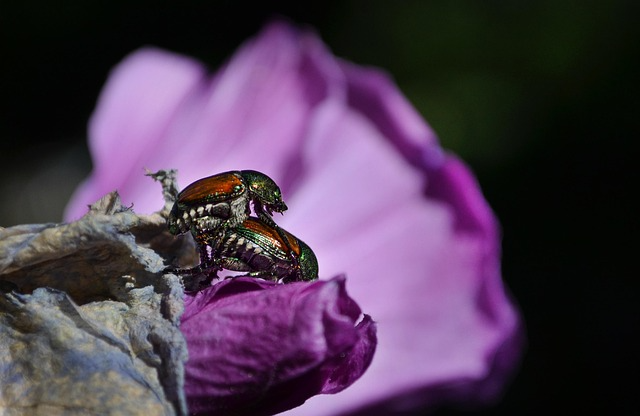
Final Thoughts
The Japanese beetle is a striking reminder that sometimes beauty hides a darker side. Originally from Japan, this beetle has become one of North America’s most notorious pests, wreaking havoc in gardens, farms, and natural ecosystems. However, by learning about its lifecycle, behavior, and vulnerabilities, we can find effective ways to manage its presence.
If you spot these beetles in your yard or are curious about invasive species, taking the time to educate yourself is a great first step. This knowledge can really help in minimizing their impact.


